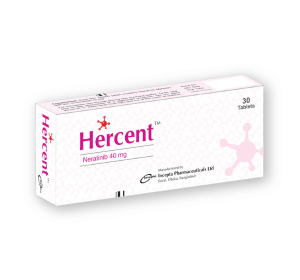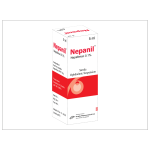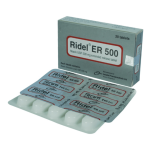Hercent(Neratinib Tablet)

Therapeutic Group: protein kinase inhibitors
Presentation
Hercent TM 40: Each film coated tablet contains Neratinib Maleate INN eqv. to Neratinib 40 mg.
Description
Neratinib is a kinase inhibitor that irreversibly binds to Epidermal Growth Factor Receptor (EGFR), Human Epidermal Growth Factor Receptor 2 (HER2), and HER4. Neratinib is a member of the 4-anilino quinolidine class of protein kinase inhibitors.
Indications
Neratinib is a kinase inhibitor indicated:
– As a single agent, for the extended adjuvant treatment of adult patients with early-stage HER2-positive breast cancer, to follow adjuvant Trastuzumab based therapy.
– In combination with Capecitabine, for the treatment of adult patients with advanced or metastatic HER2-positive breast cancer who have received two or more prior anti HER2 based regimens in the metastatic setting.
Dosage & Administration
– Premedication for diarrhea: When not using dose escalation, initiate loperamide with the first dose of Neratinib and continue during the first 56 days of treatment. After day 56, use loperamide to maintain 1–2 bowel movements per day.
– Extended adjuvant treatment of early-stage breast cancer: 240 mg (6 tablets) given orally once daily, with food, continuously until disease recurrence for up to one year.
– Advanced or metastatic breast cancer: 240 mg (6 tablets) given orally once daily with food on Days 1–21 of a 21-day cycle plus capecitabine (750 mg/m2 given orally twice daily) on days 1–14 of a 21-day cycle until disease progression or unacceptable toxicities.
– Dose escalation: A two-week dose escalation for Neratinib may also be initiated.
– Hepatic impairment: Reduce starting dose to 80 mg in patients with severe hepatic impairment.
The recommended starting dose is 240 mg daily.
First dose reduction: 200 mg daily.
Second dose reduction 160 mg daily.
Third dose reduction: 120 mg daily.
Neratinib Dose Modifications and Management- General Toxicities;
Grade 3- Hold Neratinib until recovery to Grade < 1 or baseline within 3 weeks of stopping treatment. Then resume Neratinib at the next lower dose level.
Grade 4- Discontinue Neratinib permanently.
Side Effects
“The most common adverse reactions (reported in > 5% of patients) were:
– Neratinib as a single agent: diarrhea, nausea, abdominal pain, fatigue, vomiting, rash, stomatitis, decreased appetite, muscle spasms, dyspepsia, AST or ALT increased, nail disorder, dry skin, abdominal distention, epistaxis, weight decreased, and urinary tract infection.
– Neratinib in combination with capecitabine: diarrhea, nausea, vomiting, decreased appetite, constipation, fatigue/asthenia, weight decrease, dizziness, back pain, arthralgia, urinary tract infection, upper respiratory tract infection, abdominal distention, renal impairment, and muscle spasms. “
Precautions
– Diarrhea: Diarrhea should be managed through either Neratinib dose escalation or loperamide prophylaxis. If diarrhea occurs despite recommended prophylaxis, treat with additional antidiarrheals, fluids, and electrolytes as clinically indicated. Withhold Neratinib in patients experiencing severe and/or persistent diarrhea. Neratinib should be Permanently discontinued in patients experiencing Grade 4 diarrhea or Grade > 2 diarrhea that occurs after maximal dose reduction.
• Hepatotoxicity: Neratinib should be Withhold in patients experiencing Grade 3 liver abnormalities and permanently discontinue Neratinib in patients experiencing Grade 4 liver abnormalities.
– Embryo-Fetal Toxicity: Neratinib can cause fetal harm. Should Advise patients of potential risk to a fetus and to use effective contraception.
Use in Pregnancy & Lactation
Use in Pregnancy: Neratinib can cause fetal harm when administered to a pregnant woman. Pregnant women should be advised of the potential risk to a fetus. Lactation: No data are available regarding the presence of Neratinib or its metabolites in human milk or its effects on the breastfed infant or on milk production.
Females and Males of Reproductive Potential: Males and females of reproductive potential should be advised to use effective contraception during treatment with Neratinib and for at least 1 month after the last dose.
Pediatric Use: The safety and efficacy of Neratinib in pediatric patients has not been established.
Geriatric Use: The incidence of serious adverse reactions in the Neratinib arm vs. placebo arm was 7.0% vs. 5.7% (< 65 years-old) and 9.9% vs. 8.1% (< 65 years old).
Hepatic Impairment: No dose modifications are recommended for patients with mild to moderate hepatic impairment (Child Pugh A or B). Neratinib dosage should be reduced for
patients with severe hepatic impairment
Drug Interaction
– Gastric acid reducing agents: Avoid concomitant use with proton pump inhibitors. Separate Neratinib by at least 2 hours before or 10 hours after H2-receptor antagonists. Or separate Neratinib by at least 3 hours after antacids.
– Strong CYP3A4 inhibitors: Should avoid concomitant use. – P-gp and moderate CYP3A4 dual inhibitors: Should avoid concomitant use.
– Strong or moderate CYP3A4 inducers: Should avoid concomitant use.
– Certain P-gp substrates: Should Monitor for adverse reactions of P-gp substrates for which minimal concentration change may lead to serious adverse reactions when used concomitantly with Neratinib.
Over Dose
In the event of an overdose, administration should be withheld and general supportive measures undertaken.
Storage
Do not store above 30 °C. Keep away from light and out of the reach of children.
Commercial Pack
Hercent TM 40: Each box contains 3 blister strips of 10 tablets.



